



Skin Strength
Tech Info 12 from the Canadian Poultry Industry Council explains the causes for the rise in skin tears in broilers during processing. These include Oily Bird Syndrome, disruption to collagen synthesis and the use of certain anticoccidials.The Problem
Skin tears with chicken broilers is becoming a major consideration for the industry. A skin break in the growing house makes the bird prone to bacterial invasion and thus potential increased mortality due to cellulitis. A high incidence of cellulitis can lead to a higher condemnation rate and/or an increase in carcasses that are trimmed at the processing plant. While skin tears can be increased due to poor management conditions (eg. inappropriate feeder and water height, crowding, etc.) or rough handling during catching, crating and shackling, skin strength is also a possible cause of increased skin tear.
Skin is high in the protein collagen which adds tensile strength and rigidity to this carcass component. Thus along with research undertaken to study the factors leading to increased incidence of skin tearing, collagen metabolism has also been investigated.
The following review covers reports from the early demonstration of the problem up to present day findings.
Oily Bird Syndrome
A variety of problems associated with the processing of broilers was collectively described as the oily bird syndrome (OBS), (Garrett 1975). These problems included;
- birds that had an oily skin appearance, which gave a “greasy like” feel
- birds with torn skins
- birds with water or mucous like pockets under their skin
While numerous factors such as environmental temperature, diet energy level, type of dietary fat, etc., had been suggested as possible contributors to the OBS, a wide variety of studies have indicated that no environmental, or dietary factors consistently accounted for the appearance of OBS (Thomason 1979).
Despite the wide range of conditions covered in the description of the OBS it was demonstrated that tender skin was the single characteristic common to all types of OBS. It was suggested that stress factors, in bird handling and processing, might injure or rupture the skin and under-laying fat pads, thus allowing pockets to form under the skin which would fill with water during processing. Evidence that increasing the severity of processing, increased the extent of OBS supported the suggestion that skin integrity played a major role in the incidence and degree of OBS.
Collagen
The principle structural component of skin and connective tissue is the protein collagen. Smith et al (1977) examined certain properties of skin collagen from broilers but were unable to determine any consistent factor that would account for the incidence of OBS. Ramshaw et al (1986) examined mechanical and chemical properties of skin collagen from broilers, exhibiting OBS and those that did not. Their results indicated;
- skin thickness was the same for both groups of birds
- melting temperature for skin collagens was the same
- the skin from OBS birds was weaker than that from the non affected birds
Of extreme interest was their observation that birds from a flock showing up to 20% OBS, which did not exhibit OBS, showed a difference in collagen structure as compared to birds from a flock not showing OBS. Collagen crosslinking was lower in skin of the OBS flock compared to the non OBS flock. Such an observation is consistent with the weaker mechanical properties of the skin of OBS birds. The above would suggest some environmental or dietary factor reduces the skin integrity of a flock, with the more susceptible birds thus being more prone to OBS.
Factors Influencing Collagen Synthesis
Smith et al (1977) examined possible factors influencing collagen metabolism. Higher energy diets were investigated as there were reports that “fatter” carcasses were more prone to skin tearing. Since collagen is very high in the amino acid hydroxyproline, diets high in meat meal, a good source of this amino acid, were studied along with diets supplemented with iron and ascorbic acid as these nutrients are required in the enzymatic step where proline is hydroxylated. None of the diets studied had any influence on collagen metabolism or skin integrity of broilers. Females were shown to have a higher percentage of insoluble collagen (that is not solubilized in a warm salt solution) in their skins than male broilers. However, total skin collagen was similar for both sexes.
Skin Composition
Grey et al (1984) analyzed a composite sample of skin from male and female broilers. The results obtained (Table 1), demonstrated that protein content is higher with skin from males and it decreases with age, while fat content is higher for females and it increases with age. Mineral content, while showing some small differences between the sexes and with age, is obviously influenced by the change in protein and fat content of the skin.
Skin Breaking Strength
Kafri et al (1984) measured skin breaking strength in two lines of broilers selected for high and low body weight. The higher weight birds had the greatest breaking strength as compared to the low weight birds. Breaking strength was greater for breast as compared to thigh skin. Kafri et al (1985) also investigated the effect of varying the calorie:protein ratio of the diet on various skin parameters. Birds fed diets containing higher energy levels (wide C:P ratio) had weaker skins than lower energy diets (narrow C:P ratio), (Table 2). Regardless of diet males had stronger skin than females, with breast skin being stronger than thigh or back. While collagen content of the skin decreased with age, and was lower for females than males, there were no consistent differences associated with percent collagen or protein and fat and skin breaking strength.
Skin Tearing and Coccidiostats
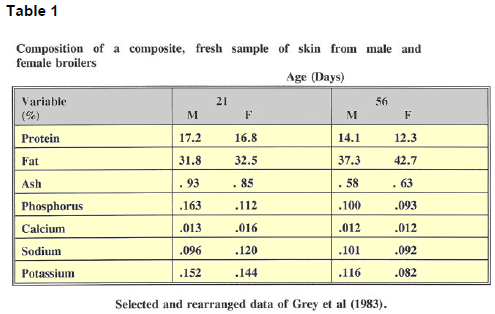
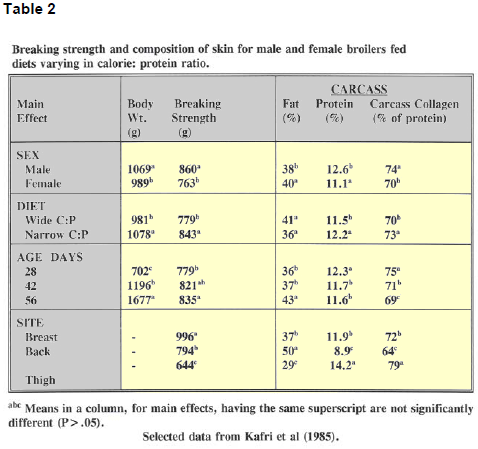
The problem of skin tearing with broilers can be a significant problem in regular processing plants. However, for Kosher processing, where hot water scalding is not permitted it can be a major problem. Angel et al (1985) reported that skin tearing had become a significant problem in Israel in the mid eighties where an incidence of 80% was encountered with some processing plants. At this time a new coccidiostat, halofuginone (Stenorol:an alkaloid) had been introduced into the country. These workers compared it to the coccidiostat Coban in tests with female broilers. The halofuginone fed birds had a higher percent of skin tears and a lower tensile strength than did birds fed Coban. (Approximately 25 versus 8%)
Skin Tensile Strength
Weenberg et al (1986) confirmed some of the previous reports showing that the tensile strength of both male and female broilers increased with age, with the males always higher than the females. Female skins had a higher fat content than males and this increased with age. Diet energy level filed to influence tensile strength of skin.
Kafari et al (1986) looked at skin tensile strength in relation to skin thickness. Males demonstrated stronger, and thinner skin than females, with the difference in thickness due mainly to the fat rich tissue beneath the epidermal layer. They concluded that increased dietary energy leads to thicker skins, due to increased fat deposition. These are weaker skins and thus skins more prone to tearing.
Strain Differences
Granot et al (1991 (a) studied collagen metabolism both in Vivo and in Vitro experiments when broilers were fed halofuginone and several other coccidiostats. Their results clearly demonstrated that halofuginone, unlike the other coccidiostats studied, suppress the synthesis of skin collagen by skin fibroblasts. Christensen et al (1994) presented similar data for birds fed halofuginone, and also concluded that the skin of females was more prone to the reduction of collagen synthesis and thus more sensitive to skin tearing than males.
Potential for Genetic Selection
Cahaner and Gutman (1993) looked at divergently selected broilers, for low or high abdominal fat, and for protein, fat and collagen from samples of breast skin. Skin of the low fat birds had lower fat, higher protein and collagen, and had a 50% lower incidence of tears as compared with the high fat birds or commercial broilers. They concluded that incidence of skin tears could be reduced by selection for low breast skin fat with biopsy samples.
A Rapid Method for Measuring Skin Strength
Bilgili et al (1993) developed a skin punch technique which proved to be simple, rapid and consistent in measuring skin characteristics. They reported that skin from slow-feathering strain crosses appeared to be less elastic as compared to that of fast feathering crosses.
Shuttle Anticoccidial Programs
Zimmermann et al (1994) fed halofuginone and salinomycin, in all 4 possible combinations, during the starter (0-3 weeks) and grower (3-6 weeks) periods. Continuous feeding of halofuginone reduced skin strength while salinomycin or either of the shuttle programs resulted in birds with similar skin strength (Table 3).

Pinon et al (1995) looked at shuttle programs with halfuginone and salinomyin. However, they also imposed two dietary treatments. Regular starter and grower diets fortified with proline from natural sources, and supplemented with vitamin C and additional zinc. There were no difference in weight gain or various skin parameters measured at 42 days of age for the dietary treatments (Table 4). Skin strength was significantly reduced for birds fed either halofuginone continually (HH) or in HS or SH programs, while skin tears and scratches were significantly higher for birds fed on the HH program, and lowest for the SS program.

L-Proline Supplementation
Christentsen et al (1995) looked at supplementing broiler diets with L-proline, which plays an important role in collagen synthesis. Glutamic acid, a precursor of proline, was also investigated as a dietary supplement. Halofuginone resulted in birds with inferior skin characteristics as compared to salinomyin. Proline supplementation resulted in significant improvements in skin strength of males but little or no difference was noted in skin collagen levels (Table 5). L-proline supplementation also improved skin strength of females. However, a diet formulated to contain a high level of proline from natural feedstuffs, or a L-glutamic acid supplemented failed to increase skin strength when added to a basal diet containing halofugionine (Table 6).
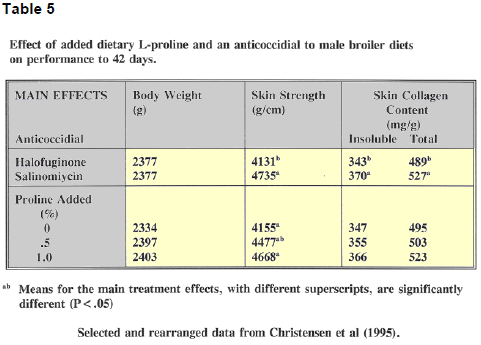

Pitcovski et al (1994) followed over 500 commercial flocks through Kosher slaughter processing (no scalding) in Israel over a 3 year period. Previous observation had suggested that females were more prone to skin tearing and subsequent muscle shedding than were males. This was borne out in their study (Table 7), which also showed that skin tearing and muscle shedding were higher in the summer months. In a controlled study they found that rearing temperature followed a similar pattern to that seen with the commercial survey (Table 8).

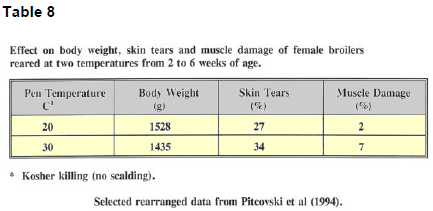
While there are a number of factors that can influence the incidence of skin tears, there would appear to be no simple solution to what continues to be a complex and costly problem. It is obvious that certain anticoccidial programs can result in a higher incidence of skin tears. However, the exact mode of action of such programs has not been elucidated.
While collagen protein plays an important role in skin strength and elasticity, the level of hydroxylproline, an important amino acid in collagen metabolism, does not correlate well with skin tear strength. Proline, glutamic acid, vitamin C and zinc are all known to be closely involved in the synthesis of hydroxyproline, but again studies have failed to show any consistent effect of dietary supplementation of these nutrients on the incidence of skin tears.
While the average grower may not appreciate the significance of the skin tear problem, it is something that has plagued the industry for quite some time and the cost to the industry continues to increase as condemnations and carcass trim increases.
References
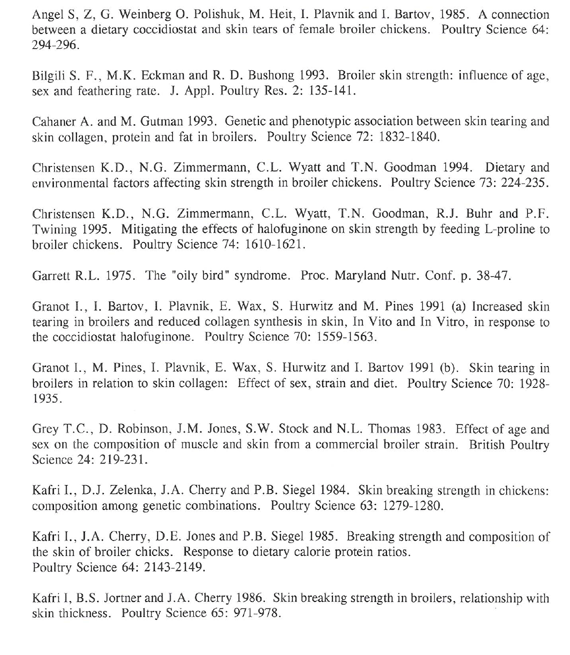
November 2008








